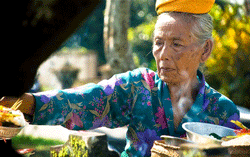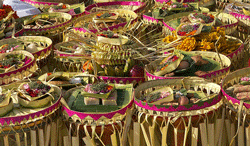BALI ANJANI VACATIONS provides accommodations, hotels, villas, Tour Packages and General Information for your lovely holiday in Bali and Beyond
Popular Posts
-
In the wilds of Denpasar and hidden away in small villages, Bali’s traditional healers dispense what is needed to keep the Balinese people...
-
Happy Anniversary... Indonesia! We're proud to be Indonesian! Make a wish for this lovely country...
-
Balinese Hindus observe the state laws of Indonesia and also the complex traditional guidelines ( adat or Desa Pekraman ) which govern cult...
-
Happy Galungan Day (8 Dec 2010) and Kuningan Days (18 Dec 2010) Galungan Days are the important religious celebrations for Balinese Hindus...
-
BALI ANJANI VACATIONS provides accommodations, hotels, villas, Tour Packages and General Information for your holiday in Bali and Beyond We...
MERRY CHRISTMAS and HAPPY NEW YEAR 2011
GALUNGAN & KUNINGAN FESTIVALS
Happy Galungan Day (8 Dec 2010) and Kuningan Days (18 Dec 2010)
Galungan Days are the important religious celebrations for Balinese Hindus. The Galungan festivity marks the victory of dharma (order) over adharma (disorder).

According to the local legend, centuries ago, Bali came to be ruled by a cruel, godless tyrant named Mayadenawa, who banned religious festival, tore down temples and punished anyone caught worshipping their Hindu gods. While he reigned, pestilence and famine raged across the island. The crops withered, rivers turned dry and people grew sick. Indra - god of storms and war - heard the island's prayers and came to earth with a great army to destroy Mayadenawa. Following the terrible battles, the evil king was killed in the hills of Gianyar. He died on Rebo (Wednesday) of the 11th week of Pawukon calendar. Mayadenawa symbolizes the adharma and the day of his killing marks the victory of dharma over adharma. The Balinese Hindus express this victory with prayers, the feast, offerings and also the get-togetherness.
Balinese Hindus use the Saka lunar calendar and the 210-day Pawukon calendar. Each of 30 seven-day weeks in one Pawukon cycle has unique name. The ten days between Wednesday of Dungulan, the 11th week, and Saturday of Kuningan, the 12th week, are a period called Galungan Days, starting on the Galungan and ending on the day Kuningan.
In the Gregorian calendar system, this year, Galungan Day occurs on Dec 08' (2010).

However, from six days before the celebration people are busy preparing the festivity. Started on Dec' 02, six days before the main celebration, called Sugian Jawa, is a special day to put the special offerings mainly in family temples for Gods and Goddesses, as the manifestation of the Almighty, while saving a prayer to purify ourselves. On the next day, called Sugian Bali, the same ritual activities with the preceding day are held.

On the Sunday (3 days before Galungan) called Penyekeban, from sekeb (to cover up), green bananas are sealed in huge clay pots upon which a small coconut husk fire burns. Lots of bananas are required for Galungan offerings, and this treatment ripens them quickly. This day is also believed as the day when Sang Kala Tiga (invisible disturber) is coming down the earth to seduce people to do bad things. Until the Galungan day comes, it is believed that Sang Kala Tiga is around us, so people should alert themselves by doing many good things and ritual to cast away the devil. The men set up the equipment associated with Galungan Ceremony such as bamboo, young coconut leaves and various kinds of flowers, material for making offering, while the women prepare various kinds of fruits.

The next day (2 days before Galungan) called Penyajaan, is devoted to making the many colored cakes of fried rice dough, jaja. This jaja is used to make offerings. The men decorate the family temple with white and yellow cloths which means the symbol of purity, and black white cloths (looks like chess board colors) which means the symbol of harmony, while the women very busy make various kinds of cakes for offering.

On the day before Galungan, called Penampahan - from nampah meaning to slaughter an animal-pigs or turtles are killed for the traditional Galungan morning feasts. Early morning the men join with their neighbors to slaughter a pig, than cook any types of Balinese dishes: lawar (a spicy hash of mixed vegetables teamed with meat and often fresh pig's blood), komoh, serapah, kuwah balung, sate lilit, jukut ares, tum bungkil and grill some chickens for the offering, at noon the men make a long bamboo pole or Penjor - an offering suspended from tall, curved bamboo pool with decorations. The arch represents Mt. Agung, the body is river that flows from the mountains to the sea, and along its route are the products of the harvest, tied to the pole; at the foot of the pole is a temporary shrine. It's also erected to welcome the victory day - to decorate the entrance of family compound. By late afternoon a day before Galungan Day, all over Bali decorated by penjor creating a very festive atmosphere in the street. While the women of the household have been busy for days creating beautifully woven 'banten' (offerings made from young coconut leaves)

Galungan day is a time for prayer, family get-together and offering. People pray at the family temples and other holy places to pray, dressed in colorful Balinese costumes. Women carry the offerings on their heads and men bring palm leave offerings in their hands, while the children walk hand in hand next to their parents. Usually people who live in town go to the hometown to visit their elders.
The day after Galungan, called Manis Galungan, is a time for visiting friends and relatives ; they forgive each other and remain together. It is also a day to relax and visit places of interest, after the long days of preparations for the celebration… and of course, the roads are packed with cars and motorcycles.

Ten days after Galungan Day Balinese Hindu followers will celebrate the prosperity day of Kuningan – kuning means yellow; this day Balinese Hindu make special offerings made from yellow rice) - which falls on Saturday (Saniscara), is the day when Gods and Goddesses accompanied by the holy ancestral spirits (pitara) come down to earth again to bless the people and the universe. It is believed that they will return to heaven in the midday. On this day, Balinese people do self-introspection by doing a meditation for human's prosperity. To the Balinese Hindu followers, the Kuningan Day is a time for commemoration say thanks to the gods for his mercy to the human races. Balinese Hindu has temple festival at Sakenan Temple on Kuningan Day, located in Serangan Island, known as Turtle Island.
If you happen to visit Bali ahead of Galungan Days, you'll discover that most temples are attractively decorated, dressed up with batik and white or yellow cloths wrapped around their individual shrines. The streets are lined with Penjor.
Continue to read...
|
Bali Anjani Vacations Main menu : provide all info about Bali ; culture, ceremonies, dance... share Bali reality faces... info about place of interest to visit and recommended tour program... Beyond Bali and Extension Program info about beyond Bali program and extension package... recommended more activities... find all Bali Hotels Website here for direct booking... find all Bali Villas Website here for direct booking... |





